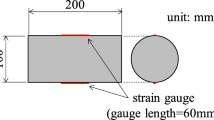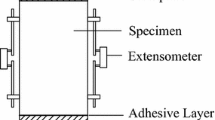Abstract
Concrete crack resistance is an important factor affecting the durability of concrete structures. In order to provide the basis for the evaluation of crack resistance of high volume fly ash concrete (HVFAC), the early-age tensile properties (i.e. tensile strength, tensile elastic modulus and tensile strain capacity) of HVFAC were investigated with direct tensile tests. The results showed that the development of tensile strength, tensile elastic modulus and tensile strain capacity of concrete before 7d decreased with the increase of water-binder ratio and fly ash content, and the tensile elastic modulus decreased significantly when the fly ash content was 60%. The development of tensile strain capacity and tensile strength of concrete from 7 to 28d was remarkably faster when the fly ash content increased, while no significant effect of fly ash content on the development of the tensile elastic modulus at late ages was observed. The tensile strength to cubic compressive strength ratio (T/C) peaked at about 2d, then showed a decreasing trend and stabilized in the range of 0.055–0.132 after 7d. Moreover, the tensile strength, tensile elastic modulus and tensile strain capacity showed a good correlation with the cylindrical compressive strength of concrete. Their respective relationships with cylindrical compressive strength were proposed and could be used to predict the tensile strength, tensile elastic modulus and tensile strain capacity of HVFAC.













Similar content being viewed by others
References
Zhao Z, Wang K, Lange D, Zhou H, Wang W, Zhu D (2019) Creep and thermal cracking of ultra-high volume fly ash mass concrete at early age. Cem Concr Compos 99:191–202. https://doi.org/10.1016/j.cemconcomp.2019.02.018
Bouzouba N, Zhang M, Malhotra V (2001) Mechanical properties and durability of concrete made with high-volume fly ash blended cements using a coarse fly ash. Cem Concr Res 31:1393–1402. https://doi.org/10.1016/S0008-8846(01)00592-0
Kuder K, Lehman D, Berman J, Hannesson G, Shogren R (2012) Mechanical properties of self consolidating concrete blended with high volumes of fly ash and slag. Constr Build Mater 34:285–295. https://doi.org/10.1016/j.conbuildmat.2012.02.034
Liu J, Qiu Q, Chen X, Wang X, Xing F, Han N, He Y (2016) Degradation of fly ash concrete under the coupled effect of carbonation and chloride aerosol ingress. Corros Sci 112:364–372. https://doi.org/10.1016/j.corsci.2016.08.004
Kim T, Davis J, Ley M, Kang S, Amrollahi P (2018) Fly ash particle characterization for predicting concrete compressive strength. Constr Build Mater 165:560–571. https://doi.org/10.1016/j.conbuildmat.2018.01.059
Li Z, Fei M, Hu C, Shi X (2021) Nano-engineered fly ash-based geopolymer composites: an overview. Resour Conserv Recy 168:105334. https://doi.org/10.1016/j.resconrec.2020.105334
GB, GB/T 50146-2014 (2014) Technical code for application of fly ash concrete, Architecture and Building Press, China
ACI C318-19 (2019) Building code requirements for structural concrete. American Concrete Institute, US
Gartner E (2004) Industrially interesting approaches to ‘“low-CO2”’ cements. Cem Concr Res 34:1489–1498. https://doi.org/10.1016/j.cemconres.2004.01.021
Junaid M, Khennane A, Kayali O (2015) Performance of fly ash based geopolymer concrete made using non-pelletized fly ash aggregates after exposure to high temperatures. Mater Struct 48:3357–3365. https://doi.org/10.1617/s11527-014-0404-6
Long W, Li H, Mei L, Li W, Xing F, Khayat KH (2021) Damping characteristics of PVA fiber-reinforced cementitious composite containing high-volume fly ash under frequency-temperature coupling effects. Cem Concr Compos 118:103911. https://doi.org/10.1016/j.cemconcomp.2020.103911
Aughenbaugh K, Williamson T, Juenger M (2015) Critical evaluation of strength prediction methods for alkali-activated fly ash. Mater Struct 48:607–620. https://doi.org/10.1617/s11527-014-0496-z
Heede P, Thiel C, Belie N (2020) Natural and accelerated carbonation behaviour of high-volume fly ash (HVFA) mortar: effects on internal moisture, microstructure and carbonated phase proportioning. Cem Concr Compos 113:103713. https://doi.org/10.1016/j.cemconcomp.2020.103713
Bui P, Ogawa Y, Nakarai KK (2016) Effect of internal alkali activation on pozzolanic reaction of low-calcium fly ash cement paste. Mater Struct 49:3039–3053. https://doi.org/10.1617/s11527-015-0703-6
Alghazali HH, Aljazaeri ZR, Myers JJ (2020) Effect of accelerated curing regimes on high volume Fly ash mixtures in precast manufacturing plants. Cem Concr Res 131:105913. https://doi.org/10.1016/j.cemconres.2019.105913
Singh N, Kumar P, Goyal P (2019) Reviewing the behaviour of high volume fly ash based self compacting concrete. J Build Eng 26:100882. https://doi.org/10.1016/j.jobe.2019.100882
Herath C, Gunasekara C, Law DW, Setunge S (2020) Performance of high volume fly ash concrete incorporating additives: a systematic literature review. Constr Build Mater 258:126060. https://doi.org/10.1016/j.conbuildmat.2020.120606
Kurda R, Brito J, Silvestre J (2020) A comparative study of the mechanical and life cycle assessment of high-content fly ash and recycled aggregates concrete. J Build Eng 29:101173. https://doi.org/10.1016/j.jobe.2020.101173
Yao Z, Ji X, Sarker P, Tang J, Ge L, Xia M, Xi Y (2015) A comprehensive review on the applications of coal fly ash. Earth-Sci Rev 141:105–121. https://doi.org/10.1016/j.earscirev.2014.11.016
Alterar S, Marei NH (2021) Fly ash properties, characterization, and applications: a review. J King Saud Univ Sci 33:101536. https://doi.org/10.1016/j.jksus.2021.101536
Kumar S, Natarajan M, Karthik V, Johnpaul V (2020) Investigation on behavior of high-volume fly ash concrete made with fine aggregate replaced by steel slag. Mater Today. https://doi.org/10.1016/j.matpr.2020.10.514
Hemalatha T, Ramaswamy A (2017) A review on fly ash characteristics—towards promoting high volume utilization in developing sustainable concrete. J Clean Prod 147:546–559. https://doi.org/10.1016/j.jclepro.2017.01.114
Herath C, Gunasekara C, Law D, Setunge S (2020) Performance of high volume fly ash concrete incorporating additives: a systematic literature review. Constr Build Mater 258:120606. https://doi.org/10.1016/j.conbuildmat.2020.120606
Sivasundaram V, Carette G, Malhotra V (1990) Long-term strength development of high-volume fly ash concrete. Cem Concr Compos 12:263–270. https://doi.org/10.1016/0958-9465(90)90005-I
De Matos PR, Foiato M, Prudêncio LR Jr (2019) Ecological, fresh state and long-term mechanical properties of high-volume fly ash high-performance self-compacting concrete. Const Build Mater 203:282–293. https://doi.org/10.1016/j.conbuildmat.2019.01.074
Li G (2004) Properties of high volume fly ash concrete incorporating nanosilica. Cem Concr Res 34:1043–1049. https://doi.org/10.1016/j.cemconres.2003.11.013
Kumar B, Tike G, Nanda P (2007) Evaluation of properties of high-volume fly ash concrete for pavements. J Build Eng 19(10):906–911. https://doi.org/10.1061/(ASCE)0899-1561(2007)19:10(906)
Atis C (2003) High-volume fly ash concrete with high strength and low drying shrinkage. J Mater Civ Eng 15(2):153–156. https://doi.org/10.1061/(ASCE)0899-1561
Hashmi A, Shariq M, Baqi A (2021) An investigation into age-dependent strength, elastic modulus and deflection of low calcium fly ash concrete for sustainable construction. Constr Build Mater 283:122772. https://doi.org/10.1016/j.conbuildmat.2021.122772
Zhao H, Sun W, Wu X, Gao B (2015) The properties of the self-compacting concrete with fly ash and ground granulated blast furnace slag mineral admixtures. J Clean Prod 95:66–74. https://doi.org/10.1016/j.jclepro.2015.02.050
Fairbairn EMR, Azenha M (2019) Thermal Cracking of Massive Concrete Structures. Springer, Berlin
Yoshitake I, Komure H, Nassif A, Fukumoto S (2013) Tensile properties of high volume fly-ash (HVFA) concrete with limestone aggregate. Constr Build Mater 49:101–109. https://doi.org/10.1016/j.conbuildmat.2013.08.020
Swaddiwudhipong S, Lu H, Wee T (2003) Direct tension test and tensile strain capacity of concrete at early age. Cem Concr Res 33:2077–2084. https://doi.org/10.1016/S0008-8846(03)00231-X
Shen D, Shi X, Zhu S, Duan X, Zhang J (2016) Relationship between tensile Young’s modulus and strength of fly ash high strength concrete at early age. Constr Build Mater 123:317–326. https://doi.org/10.1016/j.conbuildmat.2016.06.145
ACI (2008) 318-08 Building Code for Structural Concrete. American Concrete Institute, US
JSCE (2013) Standard specifications for concrete structures. Japan Society of Civil Engineers, Tokyo
Altoubat S, Lange D (2001) Creep, shrinkage, and cracking of restrained concrete at early age. ACI Mater J 98(4):323–331. https://doi.org/10.1002/9781118557587.ch7
Mei S, Wang Y (2020) Viscoelasticity: a new perspective on correlation between concrete creep and damping. Constr Build Mater 265:120557. https://doi.org/10.1016/j.conbuildmat.2020.120557
Corrado M, Molinari J (2016) Effects of residual stresses on the tensile fatigue behavior of concrete. Cem Concr Res 89:206–219. https://doi.org/10.1016/j.cemconres.2016.08.014
Hannant D, Branch J, Mulheron M (1999) Equipment for tensile testing of fresh concrete. Mag Concr Res 51(4):263–267
Hammer T, Fossa K, Bjontegaard O (2007) Cracking tendency of HSC: tensile strength and self generated stress in the period of setting and early hardening. Mater Struct 40(3):319–324
Roziere E, Cortas R, Loukili A (2015) Tensile behavior of early age concrete: new methods of investigation. Cem Concr Compos 55:153–161. https://doi.org/10.1016/j.cemconcomp.2014.07.024
GB/T 175-2007 (2007) Common Portland Cement. Architecture and Building Press, Beijing
ASTM C150/C150M-20 (2020) Standard Specification for Portland Cement. West Conshohocken, PA, USA
GB, GB/T 1596-2017 (2007) Fly ash used for cement and concrete, Architecture and Building Press, Beijing
ASTM C618-19 (2019) Standard Specification for Coal Fly Ash and Raw or Calcined Natural Pozzolan for Use in Concrete. West Conshohocken, PA, USA.
ASTM C778-17 (2017) American Society of Testing Materials, Standard Specification for Standard Sand. West Conshohocken, PA, USA.
JGJ, JGJ/T 10-2011 (2011) Technical specification for construction of concrete pumping, Architecture and Building Press, Beijing
GB, GB/T 50080-2016 (2016) Standard for test method of performance on ordinary fresh concrete, Architecture and Building Press, Beijing
GB, GB/T 50081-2019 (2019) Standard for test method of concrete physical and mechanical properties, Architecture and Building Press, Beijing
Yi S, Yang E, Choi J (2006) Effect of specimen sizes, specimen shapes, and placement directions on compressive strength of concrete. Nucl Eng Des 236:115–127. https://doi.org/10.1016/j.nucengdes.2005.08.004
Tokyay M, Özdemir M (1997) Specimen and size effect on the compressive strength of higher strength concrete. Cem Concr Res 27:1281–1289. https://doi.org/10.1016/S0008-8846(97)00104-X
Zhou Y, Gao J, Sun Z, Qu W (2015) A fundamental study on compressive strength, static and dynamic elastic moduli of young concrete. Constr Build Mater 98:137–145. https://doi.org/10.1016/j.conbuildmat.2015.08.110
Yang Y et al (2008) Experimental study on tensile properties of high performance concrete at early ages. J Build Mater 11(1):94–99 (in Chinese)
Ni T, Yang Y, Gu C et al (2019) Early-age tensile basic creep behavioral characteristics of high-strength concrete containing admixtures. Adv Civ Eng 7:1–11. https://doi.org/10.1155/2019/9495231
Eren Ö (2002) Strength development of concretes with ordinary Portland cement, slag or fly ash cured at different temperatures. Mater Struct 35:536–540. https://doi.org/10.1007/BF02483121
Tangpagasit J, Cheerarot R, Jaturapitakkul C, Kiattikomol K (2005) Packing effect and pozzolanic reaction of fly ash in mortar. Cem Concr Res 35:1145–1151. https://doi.org/10.1016/j.cemconres.2004.09.030
Antiohos S, Tsimas S (2004) Activation of fly ash cementitious systems in the presence of quicklime. Cem Concr Res 34:769–779. https://doi.org/10.1016/j.cemconres.2003.08.008
Wasserman R, Bentur A (1996) Interfacial interactions in lightweight aggregate concretes and their influence on the concrete strength. Cem Concr Compos 18(1):67–76. https://doi.org/10.1016/0958-9465(96)00002-9
Rao G, Prasad B (2004) Influence of type of aggregate and surface roughness on the interface fracture properties. Mater Struct 37:328–334. https://doi.org/10.1007/BF02481679
Park B, Choi Y (2021) Hydration and pore-structure characteristics of high-volume fly ash cement pastes. Constr Build Mater 278:122390. https://doi.org/10.1016/j.conbuildmat.2021.122390
Barbhuiya S, Gbagbo J, Russell M, Basheer P (2009) Properties of fly ash concrete modified with hydrated lime and silica fume. Constr Build Mater 23:3233–3239. https://doi.org/10.1016/j.conbuildmat.2009.06.001
Zhao L, Sun W, Liao C (2009) Effect and mechanism of interaction between fly ash proportion and water-binder ratio on the creep characteristics of high performance concrete. China Civ Eng J 42(12):76–82 (in Chinese)
Alaka H, Oyedele L (2016) High volume fly ash concrete: the practical impact of using superabundant dose of high range water reducer. J Build Eng 8:81–90. https://doi.org/10.1016/j.jobe.2016.09.008
Jawahar J, Sashidhar C, Reddy I, Peter J (2013) Micro and macrolevel properties of fly ash blended self compacting concrete. Mater Des 46:696–705. https://doi.org/10.1016/j.matdes.2012.11.027
Acknowledgements
This research was supported by the National Natural Science Foundation of China (Grant Number: 51778583) and the Key Research and Development Program of Zhejiang Province (Grant Number: 2021C01060). The authors also thank everyone providing assistance for this study, extended to everyone for his contributions to the experimental work.
Author information
Authors and Affiliations
Contributions
All authors contributed to the study conception and design. Material preparation, data collection and analysis were performed by JY, SH. The first draft of the manuscript was written by JY and revised by CG. The conceptualization and methodology were designed by YY, CG. All authors commented on previous versions of the manuscript. All authors read and approved the final manuscript.
Corresponding author
Ethics declarations
Conflict of interest
The authors declare that there are no conflicts of interest regarding the publication of this paper.
Additional information
Publisher's Note
Springer Nature remains neutral with regard to jurisdictional claims in published maps and institutional affiliations.
Rights and permissions
About this article
Cite this article
Gu, C., Yao, J., Huang, S. et al. Study on early-age tensile properties of high volume fly ash concrete. Mater Struct 55, 135 (2022). https://doi.org/10.1617/s11527-022-01977-x
Received:
Accepted:
Published:
DOI: https://doi.org/10.1617/s11527-022-01977-x




